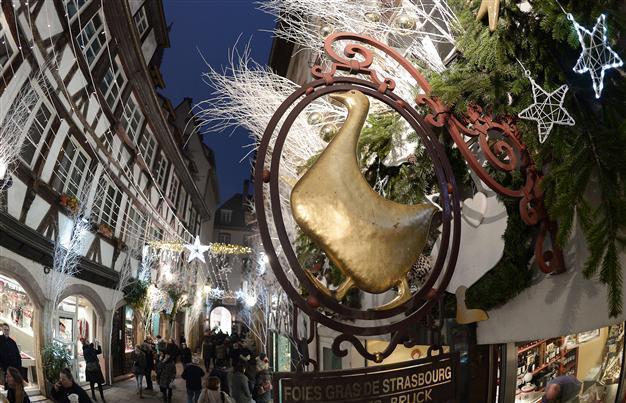
A picture taken on Dec. 3 in Strasbourg, eastern France shows the sign of a foie gras shop in a street near the city's award-winning Christmas market. With over 300 market chalets, Strasbourg attracts over two million visitors during the Christmas season. AFP Photo
Last Saturday was the day of our good old man from Demre, south of Turkey, who turned about to be the most beloved man of the children, St Nicholas aka Santa Claus. Dec. 6 is believed to be the day the saint had passed away, and the day is dedicated to commemorate his benevolent being. On the holy day, I happened to be in Alsace, where the Christmas season is exceptionally beautiful and celebrated in magical charm. It felt like it was just the right place to celebrate St Nicholas Day. The oldest Christmas market in Europe was set in Strasbourg in 1570; then called the Christkindlmärik. All the Alsatian towns welcome the Noël, or Weichnacht, in an insanely decorous and joyous way, very traditional and charming, elegantly opulent, but nothing close to the cloyingly sticky “Jingle Bells” style.
Recipe of the Week: The recipe of the past Saturday in Alsace was
naturally the “Bonhomme de Saint-Nicholas.” These man-shaped brioche
breads are typically made on Dec. 6, the day dedicated to St. Nicholas.
Children love to dip legs and arms into dense chocolate drinks and
amputate the poor pastry limb by limb.
In a large bowl mix 300 g
flour, 50 g sugar, a generous pinch of salt, 20 g yeast, 110 ml milk and
1 egg. Knead all into dough, either by hand or by hand-blender. Add and
work in 75 g melted butter until the dough is smooth and elastic. Roll
the dough into a ball, dust with flour and cover the bowl with cling
film and leave to rest in a warm place until it doubles in size. Knead
the dough once again and pull off approximately 75 g pieces. Roll into
sticks, flatten to a rectangle, and make a longitudinal cut on one side
with a knife to form legs. Pinch the other end on both sides to make a
neck and form the head; form the arms by making cuts on both sides. Push
in two raisins or blackcurrants on the head to make the eyes. Place the
little men on a backing tray lined with parchment paper. Cover and let
stand in a warm place till they double in size. Brush with egg yolk, and
bake in an oven at 180°C for 15-20 min.
Fork of the Week: Strasbourg is the capital of goose liver, foies gras. Even if we do not have the fatty delicacy in Turkey, one goose specialty is the dried cured goose from Kars, which is usually reconstituted and roasted. One holiday dinner option is available for this specialty: The Osmani Restaurant in İstinye Park has just started the goose dishes days, and can cater a whole roasted stuffed goose to your home as well. Just call 0212 345 56 00 to order.
Cork of the Week: In
Turkey, mulled wine is often badly made, never with the right spices,
often disturbingly sweet, and usually ending up as a boiled wine
“hoşaf.” However, one surprisingly nice and delicately sweetened wine
was at the bar of Morini in Zorlu Center, Istanbul. Good to have at
hand, especially if you hang out in the open air in front of the
restaurant.
Tour of the Year: My best trip this year was the
last. The Christmas markets tour to Alsace was also a gourmet tour, with
each eating venue carefully chosen, including two restaurants with a
Michelin star each in Strasbourg and Colmar; and a visit to the wine
fraternity organization Confrérerie Saint Étienne in Kientzheim, not to
mention the sweet delights in the market and the haunting smell of Vin
Chaud in the air. Wine expert Murat Yankı, who happens to own the lovely
hotel Şıra, in Cappadocia, is the ultimate tour guide; and the tour was
meticulously designed by Fikret & Martine Atalay of Koptur. Their
tours are not to be missed, either in Turkey or abroad.
Visit Koptur or Dunyanın Renkleri.